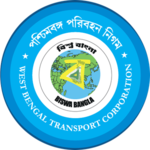
The Volvo B7RLE is a low-entry single-deck bus chassis manufactured by Volvo. It was superseded by the Volvo B8RLE in 2013.

The Kolkata Metro is a rapid transit system serving the city of Kolkata and the wider Kolkata Metropolitan Region in West Bengal, India. It is the first operational rapid transit system in India, and the second busiest metro network in India. As of January 2023 it has three operational lines: a 31.36 km (19.49 mi) line from Dakshineswar to Kavi Subhash, a 9.3 km (5.8 mi) line from Salt Lake Sector V to Sealdah, and a 6.5 km (4.0 mi) line from Joka to Taratala, for a total of 47.93 km (29.78 mi). Three other lines are in various phases of construction. The system has a mix of underground, at-grade and elevated stations using both broad-gauge and standard-gauge tracks. Trains operate between 06:55 and 22:30 IST and the fares range from ₹5 to ₹25.
Trams in India were established in the late 19th century. Horse-drawn trams were introduced in Kolkata in 1873; in Mumbai, trams began operations in 1874; in Nashik in 1889; electric trams began in Chennai in 1895, and trams were also introduced in Kanpur and Delhi. They were discontinued in all Indian cities between 1933 and 1964, except for Kolkata.

Naihati is a city and a municipality of North 24 Parganas district in the Indian state of West Bengal. It is situated in the northern part of Kolkata Metropolitan Area under the supervision of Kolkata Metropolitan Development Authority.

Tollygunge is a locality of South Kolkata, in West Bengal, India. It is known for being the center of Indian Bengali-language cinema, with filming locations used for other regional Indian films.
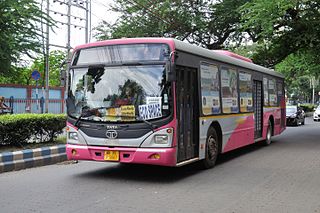
The transport system of Kolkata, a city in India, is a mix of modern mass rapid transport and old transport modalities like rickshaws. Kolkata is connected to the rest of India by the National Highways, the extensive network of the Indian Railways, National Waterways and by air. The most traffic to Northeast India route is via Kolkata.
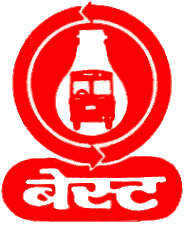
The Brihanmumbai Electricity Supply and Transport Undertaking (BEST) is a civic transport and electricity provider public body based in Mumbai, Maharashtra, India. It was originally set up in 1873 as a tramway company called "Bombay Tramway Company Limited". The company set up a captive thermal power station at the Wadi bunder in November 1905 to generate electricity for its trams and positioned it to also supply electricity to the city and re-branded itself to "Bombay Electric Supply & Tramways (BEST)" Company. In 1926, BEST also became an operator of motor buses. In 1947, the BEST became an undertaking of the Municipal Corporation and rebranded itself to "Bombay Electric Supply & Transport (BEST)". In 1995 the organisation was renamed to "Brihanmumbai Electric Supply & Transport (BEST)" alongside Mumbai. It now operates as an autonomous body under the Municipal Corporation.

Calcutta State Transport Corporation (CSTC) was a West Bengal state government undertaken transport corporation. Headquartered in Kolkata, it was set up on 31 July 1948. Currently it operates under the name WBTC. It plied buses in Kolkata and nearby districts of West Bengal, along with some long-distance services. CSTC owned 11 depots in Kolkata and the districts to station its fleet of busses.

South Bengal State Transport Corporation (SBSTC) is a West Bengal state government undertaken transport corporation. It plys buses in South Bengal and other parts of West Bengal to Durgapur and Kolkata. SBSTC owns many depots in West Bengal to station their buses. It is headquartered in Station Road, Durgapur.

Calcutta Tramways Company (CTC) was a state-run company that operated trams and buses in and around Kolkata in West Bengal, India. The Kolkata tram is the only operating tramway in India and is the oldest electric tram in India, operating since 1902.
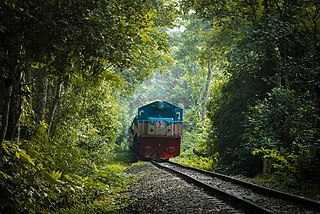
Transport between India and Bangladesh bears much historical and political significance for both countries, which possessed no ground transport links for 43 years, starting with the partition of Bengal and India in 1947. The Kolkata–Dhaka Bus (1999) and the Dhaka–Agartala Bus (2001) are the primary road links between the two countries; a direct Kolkata-Agartala running through Dhaka, the capital of Bangladesh is being developed by both countries. The Maitree Express was launched to revive a railway link between Kolkata and Dhaka that had been shut for 43 years.

Raja_bazar is a locality in the city of Kolkata in West Bengal, India. It is located in between CIT Road and APC Road. The locality has grown around Narkeldanaga Main Road, which acts as a connector between CIT Road and APC Road. Thus, Rajabazar can be said to be located between Maniktala, Narkeldanga and Sealdah.
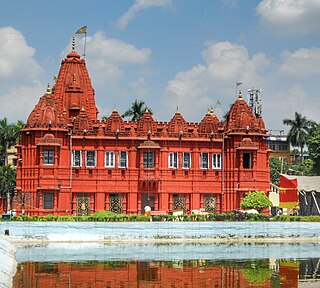
Belgachia is an area of North Kolkata in Kolkata district in the Indian state of West Bengal.

Leicester Corporation Tramways was a tramway system in Leicester, England from 1901 to 1949.

Netaji is an elevated metro station on the North-South corridor of the Blue Line of Kolkata Metro in Kolkata, West Bengal, India. This station is situated opposite to the Kudghat bus stand at Kudghat, in Tollygunge.
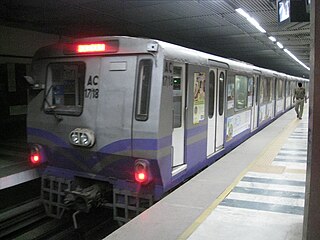
Rabindra Sarobar is an underground metro station on the North-South corridor of the Blue Line of Kolkata Metro in Kolkata, West Bengal, India. It is situated on Shyama Prasad Mukherjee Road at Charu Chandra Avenue in Charu Market, Tollygunge. The station is named after Rabindra Sarobar, an artificial lake and the surrounding area of South Kolkata. It is followed by the station Mahanayak Uttam Kumar towards Kavi Subhash and is preceded by Kalighat station towards Noapara and Dum Dum.

Belgachia is an underground metro station on the North-South corridor of the Blue Line of Kolkata Metro in Kolkata, West Bengal, India. It is located at Belgachia.

Dum Dum is an elevated metro station on the North-South corridor of the Blue Line of Kolkata Metro in Kolkata, West Bengal, India. The metro station adjoins the platforms of the Dum Dum railway station where connections can be made with Indian Railways services.

The tram system in Kolkata, the capital city of the Indian state of West Bengal, operated by West Bengal Transport Corporation (WBTC) after Calcutta Tramways Company (CTC) was dissolved, is the oldest tram network operating in India, and oldest operating tramway in Asia. Started in 1902, it is the oldest electric tramway in India. It is the only operating tram network of India at present.

Dunlop is a neighbourhood in Baranagar of North 24 Parganas district, in the Indian state of West Bengal. It is under the jurisdiction of Kolkata Metropolitan Development Authority (KMDA) and Barrackpore Police Commissionerate.
